On opposite sides of the world in 2009, two vector-borne diseases that we thought were under control - dengue fever in the Florida Keys and Human African Trypanosomiasis (AHT, more commonly known as African Sleeping Sickness) in northern Malawi - returned. AHT is one of the most dreaded tropical diseases, with good reason - it is invariably fatal in the absence of proper treatment. Over 60 million people in sub-Saharan Africa are at risk and 50,000 die each year. The main vector of AHT is the tsetse fly, and control efforts have focused on eliminating this insect from endemic regions. During the 1980's and 1990's, a successful vector control program virtually eliminated the tsetse fly from Malawi, but as the disease burden decreased, funding stopped and now it appears that they fly has returned to northern Malawi. The return of the tsetse fly isn't just bad for humans - the fly can also carry a trypanosome that fatally infects cattle, which has a severe impact on the local economy. The economic impacts can be just as devastating - a Malawian villager reported, " Our colleague last year lost almost all his cattle totaling 30 head and remained with only two. We are worried because everybody is losing livestock. The flies are bringing poverty here." Dengue fever - also known as "breakbone fever" for the severe pain caused by the first infection - is the most common vector-borne viral disease worldwide. The first infection is rarely fatal, but there are four different dengue serotypes. Infection with one serotype confers immunity to that serotype, but if someone who has already been infected with one dengue serotype is infected by a different serotype, dengue hemorrhagic fever, a life-threatening illness, can result. In May 2010, the Centers for Disease Control and Prevention (CDC) announced the first locally acquired case of dengue Fever in the United States since 1946 - and that there had likely been an ongoing outbreak of dengue in the Florida Keys since 2009. A serosurvey found that up to 5% of all Florida Keys residents have been exposed to dengue. Yes, you read the first part of that sentence correctly - we eliminated dengue from the United States when we eliminated malaria (both using vector control strategies) in the mid-40's, and now it's back. The Florida Keys are a major tourist destination, and the main fear is that dengue will spread from the Keys to the rest of the United States when travelers return home. Many of the mosquitoes in the United States are capable of transmitting the virus, so the possibility of spread is a real concern. The map below shows the distribution of Aedes albopictus, one of the main vectors of dengue, in the United States. It is present in all of the counties in red, and absent from those in blue. Gray counties represent those that the Division of Vector-Borne Infectious Diseases (DVBID) didn't have the necessary funding or manpower to survey. These two outbreaks follow the same pattern - successful vector control programs resulted in the elimination of a deadly disease, and the success of these programs led many to conclude that they were no longer necessary. The problems posed by these two outbreaks are similar, but the official responses couldn't be more different. In Malawi, the return of the tsetse fly was front page news for the Sunday edition of the national paper, while news of the dengue outbreak in the United States was somewhat more difficult to find (the New York Times ran a nice article on the subject). The Malawian government and local officials have discussed the outbreak openly, asked for help, and are proposing to fund a control initiative. In contrast, the United States has imposed severe budget cuts on the CDC, forcing the closure of the DVBID (the same division that warned us of the problem), and health officials in the Keys are denying that dengue is a problem. Which country's policies seem more sensible? More on the dengue outbreak can be found at: White Coat Underground TIME
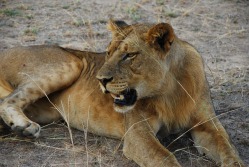 Malawi has odd visa requirements - you can stay in the country continuously for up to 3 months without any problems, but if you stay longer than 3 months than you must enter a nightmarish world of bureaucracy, fines, and paperwork to obtain a 6-month permit. However, if you leave the country after three months and re-enter, you can stay for another 3 with no problems. One of my housemates found himself in this situation, so we decided to resolve the problem in the only reasonable manner: by going on safari. Malawi has a few game parks and national preserves, but none compare to South Luangwa National Park in Zambia. Getting there was a bit of a challenge - 4 hours by bus to Lilongwe, then a 6-hour car transfer from Lilongwe (Malawi) to Mfuwe (Zambia), the last 3-hours of which are on an insanely bumpy and dusty road, and finally on to the park (after a two-hour stop at the border, the particulars of which still confuse me).
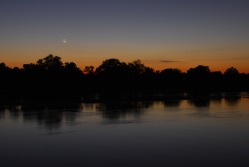 We arrived in camp around dusk, greeted by Moses (our guide) with the words "Do you want to see a crocodile?" (the answer is always yes). Disoriented from the ride, we walked about 25 feet and came to the riverbank, where we could see crocs and hippos about 10 yards away from us. After this introduction we had a brief speech about safety (don't walk alone at night; too many hippos and elephants - I thought they were joking but when I was woken up at 3AM by an elephant not three feet from my tent it became clear that that might actually be a Good Idea) and then it was off to dinner. Safaris start early (animals don't wait for people) and we hit the road at 6AM (wake-up call at 5AM) for our first trip into the bush. Honestly, I wasn't expecting much and told myself that I would be happy with seeing a few elephants, some grazers, and maybe a hippo, zebra, or giraffe. I was wrong. Within an hour we had found two lions and a herd of zebra, and before the drive was over we'd also seen 12 elephants and ambushed a herd of giraffes. The night drive (4PM to 8PM) was even better - it started off by watching a pride of lions stalk an impala (they failed), and then driving to within 2 feet of the pride, where the male proceeded to mate with the females (which they told is quite rare). Video (which is funnier than it should be) will be on YouTube soon.
As night fell, we focused on the one animal that we hadn't seen - a leopard. Although South Luangwa is one of the best places to see them, our guides warned us that we probably wouldn't get so lucky this time around. They were wrong - not only did we find a leopard with 15 minutes, we saw and helped it stalk an impala by using our car to provide cover. Stalking takes a long time, so we switched off the lights and sat in the dark for 15 minutes, listening to the impala bark at each other. We suddenly heard an impala bark much louder and then hooves running away, but when we switched the light back on we saw that the leopard had missed.
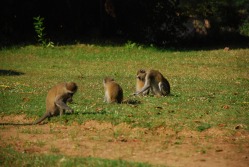 The camp at which we stayed was an adventure in itself - although we slept in tents, they had permanent beds and there were so few people that we each had a tent to ourselves so I'd hesitate to call it camping. Monkeys and baboons ran around the grounds at will, and woe be unto him who left food unattended for more than a few minutes (the monkeys are tricky devils). At night, hippos and elephants began their invasion, and you could count on waking up at least once a night thanks to nearby hippos, who are surprisingly fast out of the water.
The second day was just as exciting as the first - we saw more elephant herds, giraffes fighting, hippos eating, and a fantastic sunset over the river. We even managed to spot yet another leopard, although we only followed this one for a few minutes. After two days of safari, it was back to Blantyre, but South Luangwa is certainly a place I'd love to visit again.
The World Cup starts in South Africa this weekend, and excitement is building, especially here in Africa. As if that weren't enough, qualifications are in progress for the African Nations Championship and soccer fever is in full swing here. This fever is somewhat infectious, so when Angola played Malawi over the weekend here in Blantyre we jumped at the chance to get tickets and see the game. Seating was sold by three levels: open seating (no overhead protection from the sun and the rain), covered seating (you get to sit in the shade), and "VIP" seating (you also sit in the shade, but I think you are closer to the field). The weather was nice, so we decided on open seating (the fact that we are cheap may also have influenced this decision).
The stadium itself is a rather precarious concrete structure which looks as if collapse is a real possibility, but it's a very nice venue to watch a game - the open seating means that you can sit as close to the centerline as you dare (the rowdier locals, many of whom consume prodigious amounts of ethanol before entering the stadium, tend to prefer these seats as well) and the seats are close enough to the field where even the nosebleeds can get a good sense of the game. Getting into the stadium is an experience in itself, and the vendors who set up shop outside sell everything from coke to candy to small roasted birds on a stick (if you're feeling adventurous you can buy roasted mice with the fur intact). We arrived a bit later than planned and sat close to one of the goal lines, but our seats were right next to the stairs leading up the bleachers. This placement led to us "befriending" many of the aforementioned locals, who were shocked to see an azungu (friendlyish word for whitey) in the stands (not all too surprising, given that we one of 15, and 8 of them chose the more expensive seats).
The game itself was interesting - Angola's players seemed to suffer from a spate of sudden injuries during Malawi's drives for the goal, although thankfully these injuries resolved themselves rapidly after play had stopped and they had been taken to the sideline. The first half saw the most excitement when Angola scored 2 goals within 5 minutes, and Malawi couldn't catch up in the second half. Although Malawi lost, where else can you watch two national teams play each other for less than $2.00?
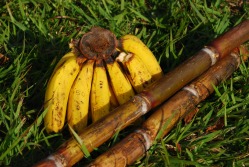 Mt. Michiru is a good-sized mountain, and since it makes for a nice outing on the weekends, we decided to climb it again this Sunday (this time the top wasn't covered in a fog bank, but we still didn't make it up early enough to avoid the dust and haze, so it looks like we'll have to return at some point). The only problem with this hike is the trails, which go straight up the hill. When the sun is shining, this approach is not so much fun (I'm not sure I'll ever adjust to the fact that it can be over 90 degrees in the winter here), so when we made it back down we were in need of some sustenance.
Fortunately, the drive from Mt. Michiru to the guesthouse passes through a market area, so we stopped off to pick up some food. Bananas, tomatoes, potatoes, and chickens (alive and dead, but in neither case plucked) were the most common items on offer, and since it is the sugarcane harvest season we also passed a few buckets of freshly harvested cane. Being the adventurous sort, we decided to stop and pick up some bananas and two sticks of cane - all for less than $0.70. Both were delicious and made for a great snack after coming down the mountain, although eating the sugarcane was much more labor-intensive than I had expected - first you have to strip the bark (using a knife is smart but the Malawians use their teeth), and then you can get to the fibers which are soaked with the sugary water. Still, totally worth the $0.15 per stick.
After nearly 40 hours of continuous travel through three countries, including 3 flights, 2 (long) layovers, and a volcano scare, I've finally made it to Blantyre, Malawi, where I'll be working on my summer internship. Jet-lagged and confused, I landed in Lilongwe, the capital of Malawi, where I met a staff member from the Malaria Alert Center who happened to be in Lilongwe for sample collection and drove me down to Blantyre.
The road from Lilongwe to Blantyre was technically a highway, but not what you or I think of as a highway. Highways in Malawi are used by everyone - pedestrians and bicyclists often outnumbered the cars, and as it got darker I began to realize why traffic accidents are a leading cause in sub-Saharan Africa (hint: horns are not always effective at getting a cyclist or pedestrian to scoot over quickly). Most stalls, selling everything from fruit to cell phones to birds on a stick (fun fact: you can buy 5 roasted birds for 100 Kwacha, less than a dollar) set up right along the roadside - there are no real exits or even places to pull over safely off the road. 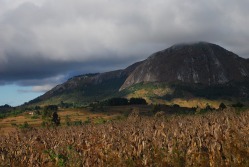 The scenery was amazing. What struck me first is how different everything is - the crows here have a whit torso, but otherwise look like the crows at home and the trees look different, although I can't quite put my finger on why that is. The daily life in Malawi is, obviously, very much not like that in America, and it's easiest to see in how young the population is (most people look to be younger than 25) and by how much work the children have to do. I saw at least 20 kids under the age of 8 herding goats and cattle on the side of the road - one 6-year old was able to herd 20 cattle with just a stick and lots of running. So after the trip, I'm finally settled in to the guesthouse in Blantyre and ready to start my summer internship - I can't wait.
|
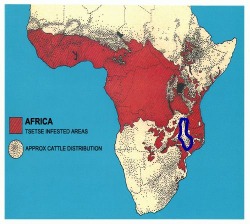
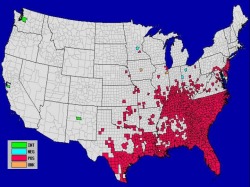





 RSS Feed
RSS Feed